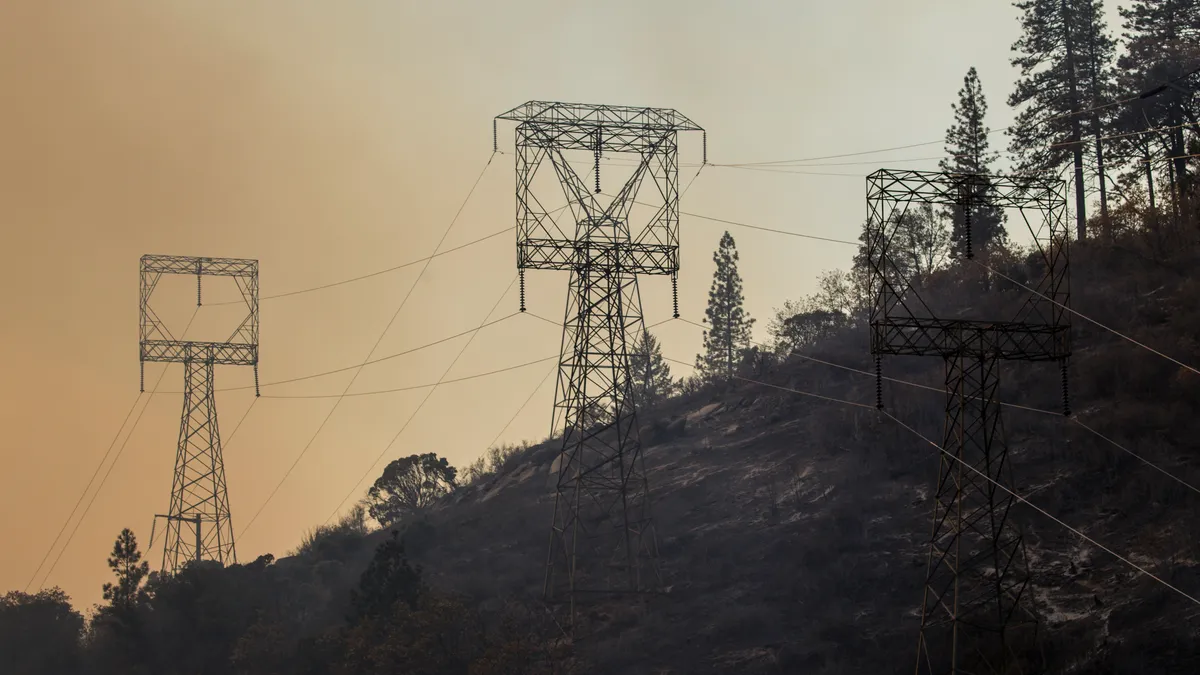Dive Brief:
- Pacific Gas & Electric failed to carry out "climbing inspections" of the transmission tower that caused the 2018 Camp Fire since 2001, violating its own inspection policies, state officials found.
-
The California Public Utilities Commission's Safety and Enforcement Division (SED) identified several gaps in the utility's attempts to properly maintain and monitor its infrastructure. These flaws were "not isolated, but rather indicative of an overall pattern of inadequate inspection and maintenance of PG&E's transmission facilities," according to a report dated Nov. 8 and made public Nov. 26.
- The SED wants regulators to include the Camp Fire in an ongoing investigation into the 2017 North Bay wildfires, also caused by PG&E's equipment, so that the utility's liabilities can be resolved before the June 2020 deadline for it to exit bankruptcy.
Dive Insight:
The SED's investigation report identified a litany of violations associated with PG&E's equipment that eventually led to the Camp Fire, which was sparked by a transmission tower in Butte County in November 2018. The fire burned across more than 153,000 acres and killed 85 people, making it the most destructive in California's history. It also pushed PG&E — already facing billions of dollars in liabilities from the 2017 North Bay fires — over the brink of bankruptcy. The transmission line has remained de-energized since.
The fire began after a worn-down C-shaped hook on one of the towers on the Caribou-Palermo transmission line broke, according to the SED's report. PG&E crews hadn't climbed and inspected that particular tower since 2001, but if they had, they "could have identified the worn C-hook before it failed and… prevented ignition of the Camp Fire," the report said.
On Nov. 26, the SED filed a motion with the CPUC to include the Camp Fire within the scope of its investigation into the 2017 fires so that regulators could review PG&E's violations "in a comprehensive manner." Another reason the SED is keen to move quickly on the investigation is the June 30, 2020 deadline by which PG&E must exit bankruptcy in order to access California's new wildfire fund. Since the Camp Fire is a "pre-petition claim" — a liability that occurred before PG&E filed for bankruptcy — it will need to be resolved before the company completes its reorganization.
According to SED's report, PG&E crews had aerially inspected the tower that caused the Camp Fire in September 2018. They noticed that a component of the tower had become disconnected, but categorized the issue as a lower priority to be corrected within a year, rather than immediately.
But when utility crews performed more detailed "climbing" inspections of the transmission towers on the Caribou-Palermo line immediately after the Camp Fire, they found a total of 524 problems — 29 of which were high-priority hazards that required immediate fixing, the SED said. The utility's broader wildfire safety inspection program, launched a month after the Camp Fire, identified more than 5,000 "hazardous conditions" on transmission and distribution facilities that had gone unnoticed before — suggesting that previous inspection and maintenance programs were inadequate, SED said.
PG&E is "deeply sorry about the role our equipment had in this tragedy, and we apologize to all those impacted by the devastating Camp Fire," utility spokesman Paul Moreno said in an email. He drew attention to the wildfire mitigation measures that PG&E has implemented since the fire, including accelerated inspections of electric infrastructure; the utility has inspected 730,000 power-lines and structures since January 2019.
"We climbed them, we used drones and we performed 18 months of inspections in only 4 months," he added.
The SED's report raises fundamental questions about how utility infrastructure has been planned across the country, Mark Dyson, principal at the Rocky Mountain Institute, told Utility Dive in an interview — that is, a centralized grid with electricity flowing from one direction to another in such a way that one disrupted component can affect everyone downstream. Systems are facing more risks driven in large part by climate change and extreme weather, Dyson said.
"Now is an important and pressing opportunity to reconsider the balance of investment in not only grid improvement and grid hardening but also resource investment and optimizing where we place generation and storage, so that those common points of failure are no longer as critical to keeping the lights on," he added.
Dyson pushed back against the notion that there are two competing solutions to the situation — either harden and modernize the grid, or disassemble it and focus on alternatives like microgrids. Instead, he advocates for a middle ground where distributed generation and storage resources are valued for resilience benefits and incorporated into utility-level resource and transmission investment planning.
"There's an opportunity here to both modernize and harden, and invest in microgrids and other distributed resources, to arrive more quickly at an investment portfolio of resources that can actually provide resilience in the near term," he said.















